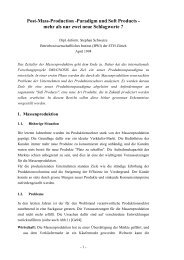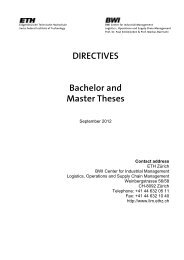The China Venture
The China Venture
The China Venture
You also want an ePaper? Increase the reach of your titles
YUMPU automatically turns print PDFs into web optimized ePapers that Google loves.
3.3.3.2 Bargaining Situation II: SME – Chinese Joint <strong>Venture</strong> Partner<br />
High-Tech SME Chinese Joint <strong>Venture</strong> Partner<br />
• Cheap production for export or<br />
• Long term foothold or<br />
• Service & maintenance<br />
• Technology as equity<br />
• Keep control of operations<br />
• Getting access to distribution networks<br />
• Short term focus<br />
• Get rid off own excess staff<br />
• Personal motives: travel, etc.<br />
• Upgrade of product and process technologies<br />
• Getting access to foreign markets<br />
TABLE 3-15: Interests, objectives and expectations between High-Tech SMEs and<br />
Chinese JV Partners<br />
When a SME considers a joint venture as entry vehicle, be it for export oriented production,<br />
getting a long term foothold in the market or to provide service and maintenance for its<br />
products, its goal is usually for a stable and long lasting presence in <strong>China</strong>. Eventual profits<br />
are often reinvested to support the future growth of the joint venture. Chinese companies tend<br />
to have a short term focus; in many cases the goal is to make profit and extract from the<br />
operation as much as possible instead of reinvesting the profit. Conflicts are difficult to avoid<br />
because the different time horizons lead to different business strategies. Equity Joint <strong>Venture</strong>s<br />
(EJV) where both parties hold an equity share are generally more stable than Contractual Joint<br />
<strong>Venture</strong>s (CJV) where co-operation is based on a contract without strict equity requirements.<br />
To minimise problems, special attention has to be given to a careful partner selection.<br />
One of the biggest problems is the valuation of assets brought into the joint venture as equity<br />
by the parties. Machinery, technology and hard currency is usually contributed by the SME<br />
while the Chinese partner provides land, eventually buildings, a sales organisation and<br />
manpower. Equity contribution in form of technology (know -how, patent rights, etc.) is<br />
restricted by law to 20% of the total equity. Often land and buildings are evaluated much too<br />
high so that the Chinese side gets the desired equity stake which is relevant for profit<br />
distribution and control of the joint venture. SMEs and MNCs alike usually have to make<br />
concessions in this question.<br />
Overstaffing is a serious problem in many Chinese companies. Getting rid of excess staff<br />
might be a motive to form a joint venture. Like in the equity issue, concessions to the Chinese<br />
side are often necessary. Both issues are hard to solve and are a common reason for the failure<br />
of JV negotiations.<br />
One important, if not the most important reason for a SME to opt for the joint venture solution<br />
is the expectation that the Chinese partner has a lot of “guanxi” and a well developed sales<br />
120






